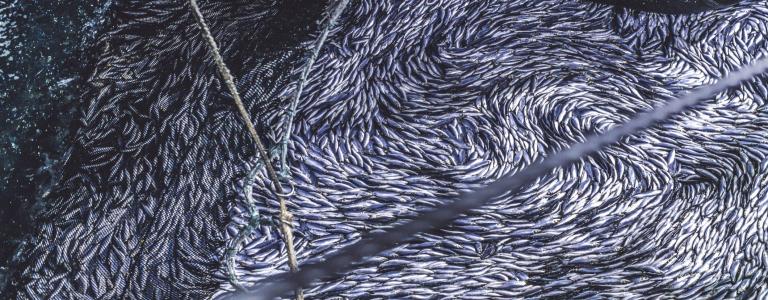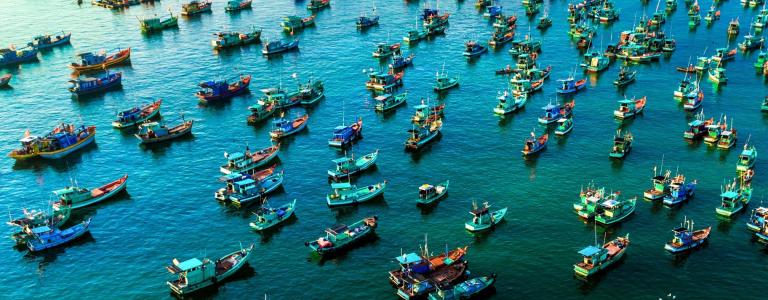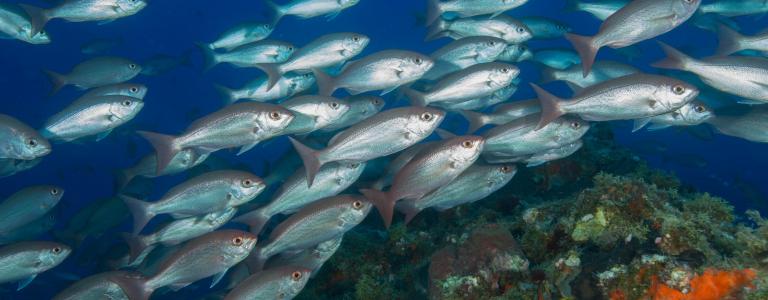The WTO and Fisheries Subsidies: Where are we, exactly?
The WTO Agreement on Fisheries Subsidies, adopted in June 2022 after more than two decades of negotiations, marked a significant milestone for promoting sustainable development in the fisheries sector and was celebrated as a historic achievement. This key international instrument requires governments to avoid financially supporting fishing in situations where there are acute concerns about the sustainability of such fishing. WTO members are still negotiating additional rules on fisheries subsidies. What would these add, and where are we exactly in that negotiating process? This article offers a concise state of play of the current WTO process on the topic.
Fish 1: The 2022 Agreement on Fisheries Subsidies
When WTO members sealed a multilateral deal to curb the most harmful forms of government subsidies to the fishing sector in 2022, they drew applause from around the world. Harmful fisheries subsidies are a serious challenge in terms of sustainable development. They encourage levels of fishing pressure that marine resources cannot bear, threatening not only marine ecosystems but also the food security and livelihoods of hundreds of millions of people who depend on fishing, often in vulnerable coastal communities in developing countries.
By prohibiting the provision of fisheries subsidies when they can be most damaging, the 2022 WTO Agreement on Fisheries subsidies (hereafter “the 2022 agreement,” also called “Fish 1”) is expected to help align government subsidy policies with sustainability imperatives in the fishing sector. This is a much-needed shift in the face of the ever-increasing share of fish stocks being exploited beyond sustainable levels globally (38%, according to the latest estimates by the Food and Agriculture Organization of the United Nations) and the well-known role of subsidies as a driver of such overexploitation. The agreement’s conclusion, therefore, was a major success.
More precisely, the treaty prohibits subsidies in three types of situations: (1) when fishing activities are illegal, (2) when fish stocks are in an overfished condition—i.e. their biomass is alarmingly low—and no measures have been introduced to help them recover, (3) when fishing occurs on the high seas outside of any collective management arrangement, which essentially means that no collective entity has the responsibility to ensure the sustainable management of these activities. In addition, the rules include a softer obligation for governments to be particularly cautious when providing subsidies to vessels that do not fly their flag and for the fishing of stocks whose sustainability status has not been assessed, as well as transparency requirements with regard to subsidies and other fisheries-related information.
The treaty now needs to be ratified by 111 WTO members to enter into force; 86 members have done so already, so 25 more ratifications are still needed. Once in force, the new set of rules will become legally enforceable. WTO members must thus also prepare to implement these new legal obligations, which they can start by using IISD’s Self-Assessment Tool for the Implementation of the Fisheries Subsidies Agreement. A dedicated fund has been set up at the WTO to provide developing country members with the financial support they need to implement the agreement.
Fish 2: Toward further, broader rules
All of this is promising, but it also raises the question of why WTO members are still negotiating to conclude additional rules on fisheries subsidies (often called “Fish 2”). The answer lies in the focused nature of the rules agreed in 2022. The 2022 agreement is essential in its own right, but the problem of subsidized overfishing is broader than the specific situations targeted by its prohibitions. Fisheries subsidies can be harmful even when fishing operators do not engage in illegal activities or when stocks are not (yet) in an overfished condition. They often encourage the development of oversized fishing fleets and incentivize excessive levels of fishing pressure, which can lead to fish stocks being overfished or even severely depleted further down the line. The original mandate for the negotiations recognized the scope of the problem: it required negotiators to discipline those subsidies that contribute to overcapacity and overfishing.
This is precisely why WTO members are currently negotiating further, broader rules on fisheries subsidies: to prevent subsidies from contributing to overfishing and fleet overcapacity in the first place. In other words, the rules would aim to address more directly the root cause of the problem (when subsidies start to encourage overcapacity and overfishing) rather than waiting for the most acute manifestations of that problem to appear (when overfishing has been going on for so long that stocks are in an overfished condition).
At the WTO’s Twelfth Ministerial Conference (MC12) in Geneva, where the 2022 agreement was adopted, such broader rules were also on the table, and their conclusion was crucial for many WTO members. However, members did not manage to agree on all the parameters of these disciplines. Rather than throwing the entire agreement overboard, they decided to conclude a smaller—but critically important—package and continue negotiating on these additional rules to prohibit subsidies that contribute to overcapacity and overfishing more generally. Now they are working to finish the job.
How far have we come?
WTO talks on fisheries subsidies resumed in 2023, with a very busy schedule of negotiating meetings throughout the year and in early 2024. The goal was to agree on additional provisions on fisheries subsidies by—or at—the WTO’s Thirteenth Ministerial Conference (MC13), held in Abu Dhabi in late February and early March 2024. Members began by reconsidering various possible approaches to these broader rules. As the discussions progressed, the chair of negotiations, Ambassador Gunnarsson of Iceland, tabled draft disciplines, which initiated a process of gradual convergence between members on most of the key elements in the rules, as reflected in a revised text issued at the end of 2023. Further negotiating meetings in early 2024 allowed members to continue narrowing gaps between positions and find further convergence on several outstanding issues. This progress was captured in a draft text for additional provisions which many members hoped to adopt at MC13.
However, despite intensive talks in Abu Dhabi and an unprecedented level of convergence on virtually all issues on the table, members could not reach full consensus at the ministerial meeting. Nonetheless, the work undertaken in Abu Dhabi generated some of the building blocks needed to conclude the talks. First, it led to another revision of the draft text (later circulated formally here, and see IISD’s analysis of it here), which brought WTO members even closer to consensus. Second, it allowed particular members to work bilaterally and find common ground on very sensitive issues on which they held diametrically opposed positions. Finally, the last hours of MC13 saw a diverse group of WTO members undertake efforts to find compromises on several outstanding issues, and the adjustments suggested by this group in a so-called “floating text” are likely to prove important in finding a landing zone.
After hearing members’ views again in the months following MC13, many of which emphasized how close members were to landing a deal in Abu Dhabi, the chair of negotiations decided to attempt to conclude negotiations in July in Geneva. He issued a slightly amended text, suggesting a possible landing zone on outstanding issues based on the so-called “floating text” from MC13 and put the decision to WTO members at the July meeting of the WTO’s General Council (the organization’s highest decision-making body outside of the ministerial conference).
This text was the basis for further discussion among members in the week before the July General Council meeting. Some members still had reservations about particular aspects of the disciplines, and members explored possible solutions to these concerns. Despite this last gap-closing work, it also became evident during that week that consensus would again prove elusive. One large developing country member, in particular, had made it clear that it would not be in a position to adopt the proposed disciplines on the table.
The current situation is a study in contrasts. On the one hand, WTO members have never been so close to consensus with regard to the actual substance of these additional rules. The overwhelming majority of them would like to conclude these negotiations by the end of the year on the basis of the current draft text, possibly with limited adjustments. On the other hand, full consensus has not materialized until now. Not all WTO members have been able to clearly signal that they would be ready to adopt the suggested disciplines, and one member has been explicitly calling for more substantial changes to the rules. For members to be able to deliver this crucial deal, a change in current political dynamics will be needed.
What disciplines are we looking at?
The draft text on the table reflects members’ gradual convergence on a “hybrid” approach that combines elements from several proposals made by different members and groups of members over the years. Overall, the structure of the rules is quite similar to the set of disciplines that were already being considered in the lead-up to MC12, yet with a few important changes.
The main rule establishes a broad prohibition of subsidies that contribute to overfishing and overcapacity. It includes a list of subsidy types that are presumed to be harmful (and thus prohibited) but is also accompanied by two types of exemptions. First, the subsidizing member can keep subsidizing when they can show that fisheries management measures are in place to keep fish stocks healthy, with stricter demonstration requirements for developed members, distant water fishing nations, and large subsidizers. This differentiation between members—i.e., tougher requirements for members with more industrialized and subsidized fishing sectors—is one of the key changes made to the draft rules over the last 2 years. Second, the main rule is tempered with a series of temporary and permanent exemptions for developing country members or groups of developing country members as special and differential treatment (SDT). Another key evolution in the draft rules since MC12 has been the gradual widening of some of these flexibilities for developing countries, in particular with regard to an exemption for subsidies provided to artisanal fishing.
This main prohibition is accompanied by a similar, conditional prohibition of subsidies that are targeted at fishing activities beyond the subsidizing member’s water, which includes a dedicated process for monitoring these subsidies. Finally, the draft text also includes a number of transparency obligations.
Are these rules worth concluding?
A central question for WTO members, as they consider their next steps in these negotiations and how they could be brought to a successful conclusion, is what the rules on the table mean in terms of sustainable development. And this reflection should be guided by at least three central considerations.
First, agreeing on these new rules is essential for protecting both marine ecosystems and the communities that depend on fishing for nutrition, jobs, and livelihoods. The suggested provisions are broader than those agreed in the context of the 2022 agreement, and so is their potential impact. These additional disciplines are key to better addressing the underlying role of subsidies as a driver of overfishing beyond the specific situations that are already addressed in the existing agreement.(*)
Second, the rules on the table are neither perfect from a sustainability perspective nor the ideal result from any member’s point of view. Precisely because of the breadth of the impact that these new disciplines could have, negotiations have been very intense and complex. The suggested new rules are the result of painstaking work to find compromises between governments with very divergent initial positions. And after years of hard negotiating work, the draft text reflects the best set of disciplines on which members have managed to find convergence. Among the options that have been proposed and discussed, some would have been more ambitious from a sustainability perspective, but they did not generate consensus among members.
Third, the draft disciplines represent significant value in terms of sustainable development. They would prohibit the riskiest types of subsidies when no credible fisheries management measures are in place. And, while the temporary exemption for developing country members’ subsidies to large-scale fishing is very wide, it would only apply for a period of time. Eventually, a large majority of subsidies to large-scale fishing would need to be accompanied by fisheries management. The permanent exemptions for developing countries—for very small fishing nations and for subsidies to small-scale fishing—will have a much smaller impact.
At a global institutional level, the disciplines would subject fisheries subsidies and their sustainability to scrutiny that currently does not exist, putting the issue explicitly on the ongoing international agenda in a WTO committee.
Most importantly, the disciplines have the potential to change what society at large expects of policy-makers across the globe—and, as a result, how policy-makers behave—as they define the support that their government provides to the fishing sector. Fisheries subsidy policies would be expected to align with sustainable development objectives, a principle that would be enshrined in a multilateral, binding set of rules for the first time.
The suggested rules are not perfect. However, from a sustainable development point of view, they hold a lot of value that should not be simply left on the table.
(*) For a slightly more detailed version of these key considerations, see the final section of IISD’s analysis here.
You might also be interested in
Landmark Agreement Curbing Harmful Fisheries Subsidies Awaits Ratification A Year After Adoption
This month marks the first anniversary of the World Trade Organization’s (WTO) historic Agreement on Fisheries Subsidies. The treaty, adopted at the WTO's 12th Ministerial Conference, established the first global, legally binding framework that limits subsidies for illegal, unreported and unregulated (IUU) fishing and fishing of overfished stocks, as well as subsidies to vessels fishing on the unregulated high seas. The agreement also calls for countries to exercise “due restraint” in providing subsidies to vessels that do not fly their country’s flag or those that fish stocks with unknown status.
Source to Sea: Integrating the water agenda in 2023
2023 could prove to be a definitive year for facilitating an integrative perspective on water issues, from fresh water to the marine environment.
S'pore becomes 2nd country to support global agreement ending harmful fisheries subsidies
Singapore has become the second member of the World Trade Organisation (WTO) to ratify its agreement to protect the world’s oceans. On Friday, the Republic formally accepted the treaty – the first multilateral trade agreement that focuses on environmental sustainability – becoming the first coastal state to do so.
A Global Deal to Tackle Harmful Fisheries Subsidies: A look behind the scenes
In June 2022, World Trade Organization members reached a historic deal tackling harmful fisheries subsidies. We unpack how a global campaign by environmental non-governmental organizations and technical policy and legal advice from trade experts in Geneva helped make a difference.


